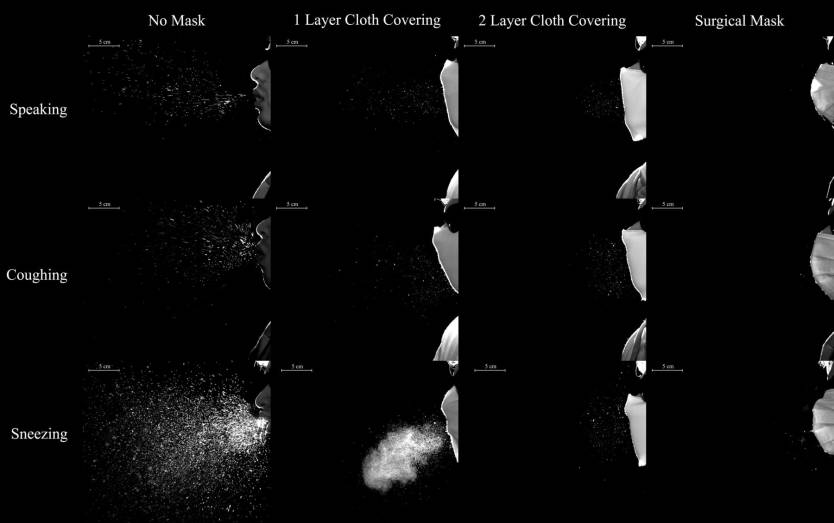- The coronavirus transmission rate can be reduced with a combination of three actions: frequent hand hygiene, social distancing, and face masks.
- The virus can spread via the air, a recent study showed just after the World Health Organization acknowledged that airborne transmission is real.
- The virus spreads while talking, sneezing, and coughing, and a face mask is the kind of obstacle that can stop the droplets and aerosols.
- A new study explains which type of homemade face cover is the safest by comparing cloth masks made of a different number of layers.
Wearing face masks while you’re sharing the same space with other people can reduce the spread of the novel coronavirus and possibly save the lives of everyone in the room and their loved ones. That includes the people who will email me to tell me how masks actually don’t work, how this is all a ploy from the government to get you to comply and other reasons that anti-maskers currently peddle. Face masks aren’t 100% effective at blocking the infections, and even if you wear them, you can still get infected. Combined with social distancing and frequent handwashing, they give you a better chance to stall for time until effective vaccines and drugs are here.
Considering the virus can spread with ease indoors, and nobody is spared, we should really take advantage of every edge we can get over the pathogen and prevent infection for as long as possible. If science can prove that tattooing the longest word in the dictionary in bolded caps somewhere where it really hurts would reduce the risk of infection, you should take advantage of that knowledge. There’s no research for that, but there’s increasing work that proves the virus spread with ease through the air, via liquid and gas particles, and that blocking your mouth and nose can prevent those particles from getting in and out.
A recent study explained what cloth face masks are the most effective, and a brand new one further refines that research, revealing what sort of homemade masks you should consider making yourself.
There’s no widespread shortage of personal protective equipment (PPE) right now, and you can find face masks of various qualities in various places. But with the novel coronavirus surging in various parts of the world, we could witness another PPE scarcity. Not to mention that some people may no longer not afford to buy face masks and N95 respirators. These considerations certainly explain why the Indian government is advising its citizens against wearing N95 respirators with valves and creating their own, reusable face masks.
Researchers at the University of New South Wales in Australia looked at how various types of homemade masks can block the spread of droplets ejected while sneezing and coughing. They used LED lighting, and a high-speed camera to film a person coughing and sneezing without a mask, and then did the same thing for single-, double-, and triple-layer masks. Surgical masks like the ones you can buy online and in stores also have three layers.
The researchers also measured speaking, capturing clips at 850 frames per second, per CNCB. Coughing and sneezing were filmed at 1,000 frames to further slow down the speed of droplets expulsion.

The researchers concluded that a single-layer mask is better than no mask if nothing else is available. The single-layer cover would reduce droplets from speaking, but the double-layer would be even better at lowering the spread of droplets from coughing and sneezing. The three-layer surgical mask was the most effective at stopping the expelled droplets, and the researchers have a video over in BMJ Thorax, showing all these experiments in action.
The single-layer mask was made of a piece of cotton T-shirt and hair ties. The double-layer cover was sewn as shown in CDC guidelines. To induce a sneeze, the researchers used tissue paper to stimulate the mucus membrane of the nasal cavity.
“A cloth face covering with at least two layers is preferable to a single-layer one,” School of Mechanical and Manufacturing Engineering’s Prateek Bahl wrote. “Guidelines on homemade cloth masks should stipulate multiple layers.”
A new study also showed that the tiny droplets that are expelled during regular talking, which turn into aerosols in the circulating air of a room, can contain viral loads that are still infectious. Just because the water evaporates quickly and the droplet becomes an aerosol, the virus isn’t killed. And aerosols have a higher chance of lingering in the air than bigger droplets that tend to land on surfaces. This makes wearing a face mask while outside the safety of your home all the more important.
If you plan on making your own reusable masks to save money or during shortages, make sure you use three layers and rely on guidelines from the CDC or your local authority.








